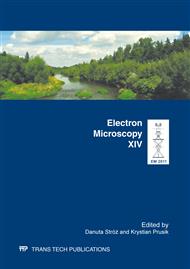p.198
p.202
p.206
p.212
p.216
p.222
p.226
p.230
p.234
Formation and Properties of Amorphous/Crystalline Ductile Composites in Ni-Ag-P Immiscible Alloys
Abstract:
The aim of the work was to investigate the influence of silver as a modifying constituent on structure formation in Ni-P based glass forming matrix. Nickel-phosphorus-based Ni80P20, Ni78Ag2P20 and Ni76Ag4P20 alloys were prepared from 99.95 wt % Ni, 99.95 wt % Ag, and Ni-P master alloy. The alloys were melt-spun in helium. The microstructure of the melt-spun ribbons was investigated by XRD, a light microscope and a transmission electron microscope. Then the tensile tests were performed. The alloys with silver show lower tensile strength with respect to the fully amorphous Ni80P20 ribbon. The ductility of the amorphous matrix melt-spun Ni78Ag2P20 and Ni76Ag4P20 alloys was improved by addition of silver forming fcc-Ag precipitates in comparison with Ni80P20amorphous alloy. SEM observations of the fracture surfaces show different character of the fractured samples. The pattern and the number of the crack lines changes, depending on the silver content. For the fully amorphous Ni80P20 alloy simple brittle cracks are observed, however the alloys with silver content show more developed surfaces near the fractured regions and form crack lines arranged 60° with loading direction.
Info:
Periodical:
Pages:
216-221
Citation:
Online since:
March 2012
Price:
Сopyright:
© 2012 Trans Tech Publications Ltd. All Rights Reserved
Share:
Citation:


